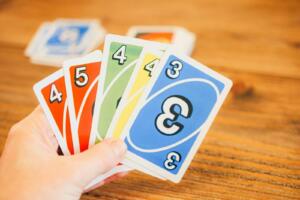Table of Contents

Party games are a reliable way to get people interacting, laughing, and enjoying themselves. They work for all sorts of occasions, from small family gatherings to larger social events. The right games can encourage conversation, teamwork, and create memorable moments without needing complicated preparation or equipment.
Introduction to Party Games
Party games are structured activities designed to entertain participants and get them moving, thinking, or interacting with others. Unlike passive forms of entertainment, these games require active participation and often involve collaboration or friendly competition. They can help break the ice, encourage social interaction, and make events more memorable.
Well-chosen games also allow people to engage in a shared experience, providing moments of laughter, problem-solving, and teamwork. They suit a variety of occasions, from casual family gatherings to larger social events, and can be adapted to suit different group sizes, ages, and energy levels. By mixing types of games, hosts can keep the event lively and inclusive, making sure that everyone feels involved rather than just observing from the sidelines.
Classic Party Games
Some games have stood the test of time because they are simple, easy to set up, and suitable for various participants. Charades, where players act out words or phrases without speaking, is popular for its fun and creativity. Musical chairs introduces both movement and timing, making it energetic for children and adults alike. Pin the Tail on the Donkey is a staple at younger children’s parties, adding suspense through blindfolded play. These games are successful because they are easy to explain and allow everyone to join, regardless of skill or experience.
Party Game Types
Party games can generally be grouped according to the type of challenge that they provide. Understanding these categories helps hosts select games that fit the space, number of participants, and style of gathering. Some games are mental or language-based, others are physically active, and some combine multiple skills.
Recognising the type of game also helps with timing an event – alternating between high-energy and low-energy activities can maintain interest and participation across longer gatherings. Hosts can tailor choices to suit indoor or outdoor settings, quiet or noisy spaces, and small or large groups, ensuring that everyone can join comfortably and safely.
Word-Based Games
Word-based games focus on language, memory, or quick thinking. Taboo asks players to describe a word without using related terms, encouraging clever descriptions. Pictionary combines drawing and guessing, relying on visual communication rather than verbal skill alone. In 20 Questions, one player thinks of an object while others guess it using yes/no questions, which encourages logical reasoning. These games are ideal for indoor settings and require minimal equipment, making them suitable for casual parties with mixed-age groups.
Action-Based Games
Action-based games involve physical movement and can bring energy to any gathering. Twister challenges balance and flexibility as players place hands and feet on coloured spots. Relay races can be customised with props like spoons, water cups, or balloons to suit different participants and spaces. Sardines, a variation of hide-and-seek where the group joins the person hiding, encourages teamwork and adds a playful twist. These activities work well outdoors or when participants want a more active experience.
Party Game Planning
Planning is important for a smooth and enjoyable game session. Key considerations include:
- Group size: Small gatherings work well with conversational or skill-based games, while larger groups benefit from team-based or rotational activities.
- Available space: Indoor games may require clearing furniture, while outdoor games need a safe, open area with room for movement.
- Duration: Short, varied games help maintain attention and energy, while longer games suit participants willing to engage for extended periods.
- Accessibility: Ensure everyone can participate comfortably, including those with limited mobility or younger players.
- Materials and setup: Prepare any props or equipment in advance to avoid delays during the party.
- Backup options: Have extra games ready to fill unexpected gaps or adapt if certain activities don’t work as planned.
- Schedule: A rough timeline keeps the session organised and ensures a smooth transition between games without long pauses.
Careful planning not only reduces interruptions but also helps participants feel involved and confident, creating a more enjoyable experience for everyone.
Themed Party Games
Themed games add cohesion to a celebration and can make it more memorable. Matching the game mechanics to the theme helps participants feel involved. Costume Bingo, where players’ outfits match a theme and are ticked off on a bingo card, combines observation with theme-based fun. Trivia nights can be adjusted to suit any theme, from decades of music to local history or favourite TV shows. Scavenger hunts allow guests to explore and collaborate, with clues designed to fit the theme. Choosing games that match the theme and participant interests keeps the focus on fun.
Outdoor Party Games
Outdoor gatherings offer more space for movement and larger-scale games. Lawn games like croquet or bocce require skill and patience, offering a calmer form of competition. Capture the Flag and similar team-based games work best for older children and teenagers, promoting cooperation and activity. Water balloon tosses or simple relay races suit summer parties, combining fun and physical activity. When planning outdoor games, consider weather, safety, and adequate space to avoid accidents.
Party Game Tips and Tricks
Running games smoothly relies on preparation and practical strategies. Keep instructions simple and concise, and demonstrate a short example before starting to ensure everyone understands the rules. Rotating different types of games keeps the event interesting; alternating calm, word-based games with higher-energy activities helps maintain focus and participation.
Additionally, using teams strategically balances skills, encourages collaboration, and allows quieter participants to join in more comfortably. Observing the group’s energy and adjusting games on the fly can prevent boredom or frustration. Finally, having a few backup games ready ensures there is always an option if a planned activity doesn’t work or interest drops.
A single numbered list works well to summarise preparation tips for easy reference:
- Explain instructions clearly and demonstrate briefly.
- Rotate games to suit energy levels and maintain interest.
- Use teams to balance skills and encourage collaboration.
- Keep backup games ready for flexibility and smooth transitions.
FAQs
What are the best Party Games for groups of different sizes and ages?
Small groups of 4–6 people suit games like Pictionary, Taboo, or 20 Questions, where everyone can participate directly. Medium groups of 7–12 benefit from team games such as Charades, relay races, or word-based challenges. Larger groups, 13 or more, work well with Musical Chairs, Sardines, or scavenger hunts, especially when using teams or rotations.



